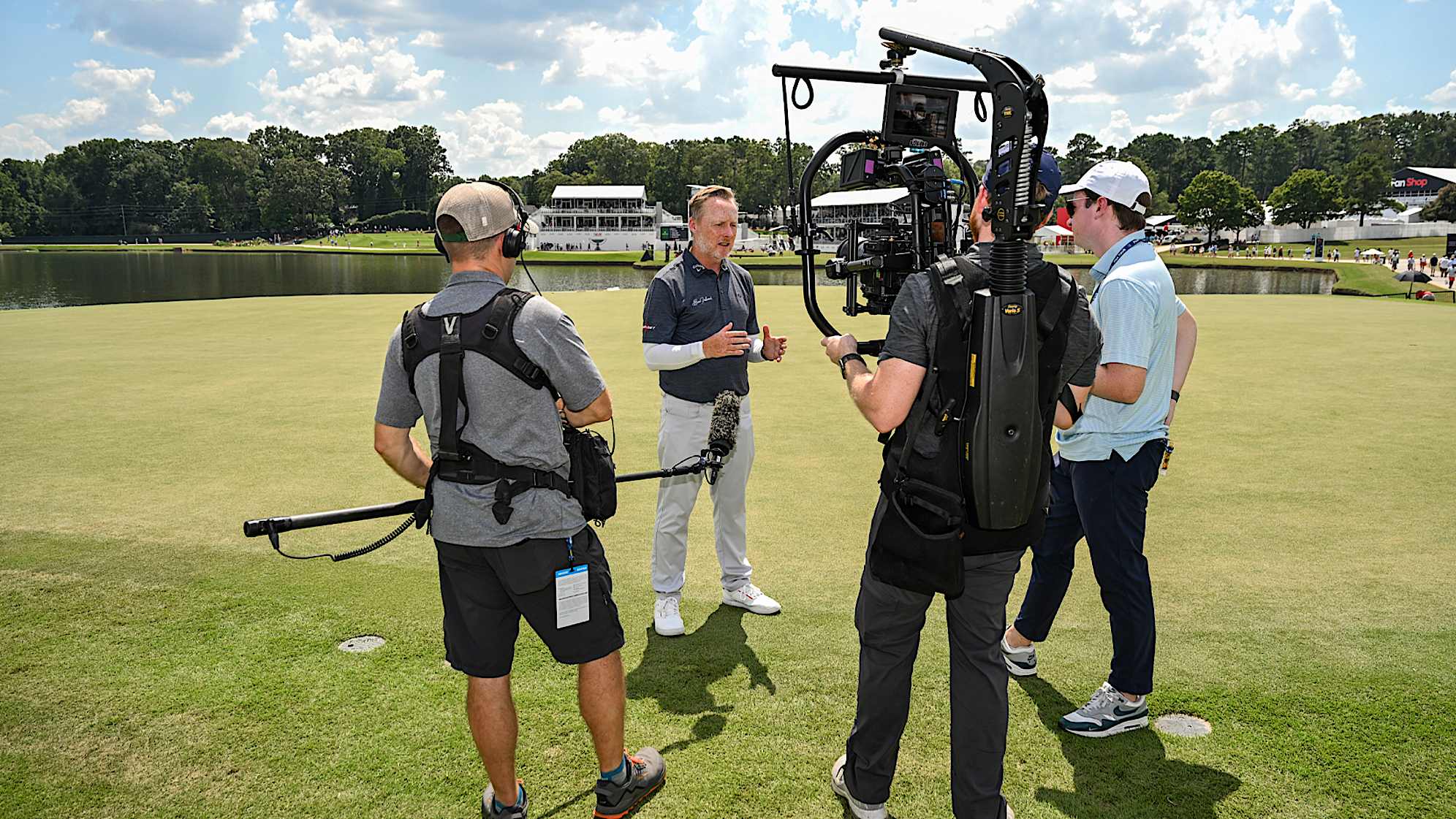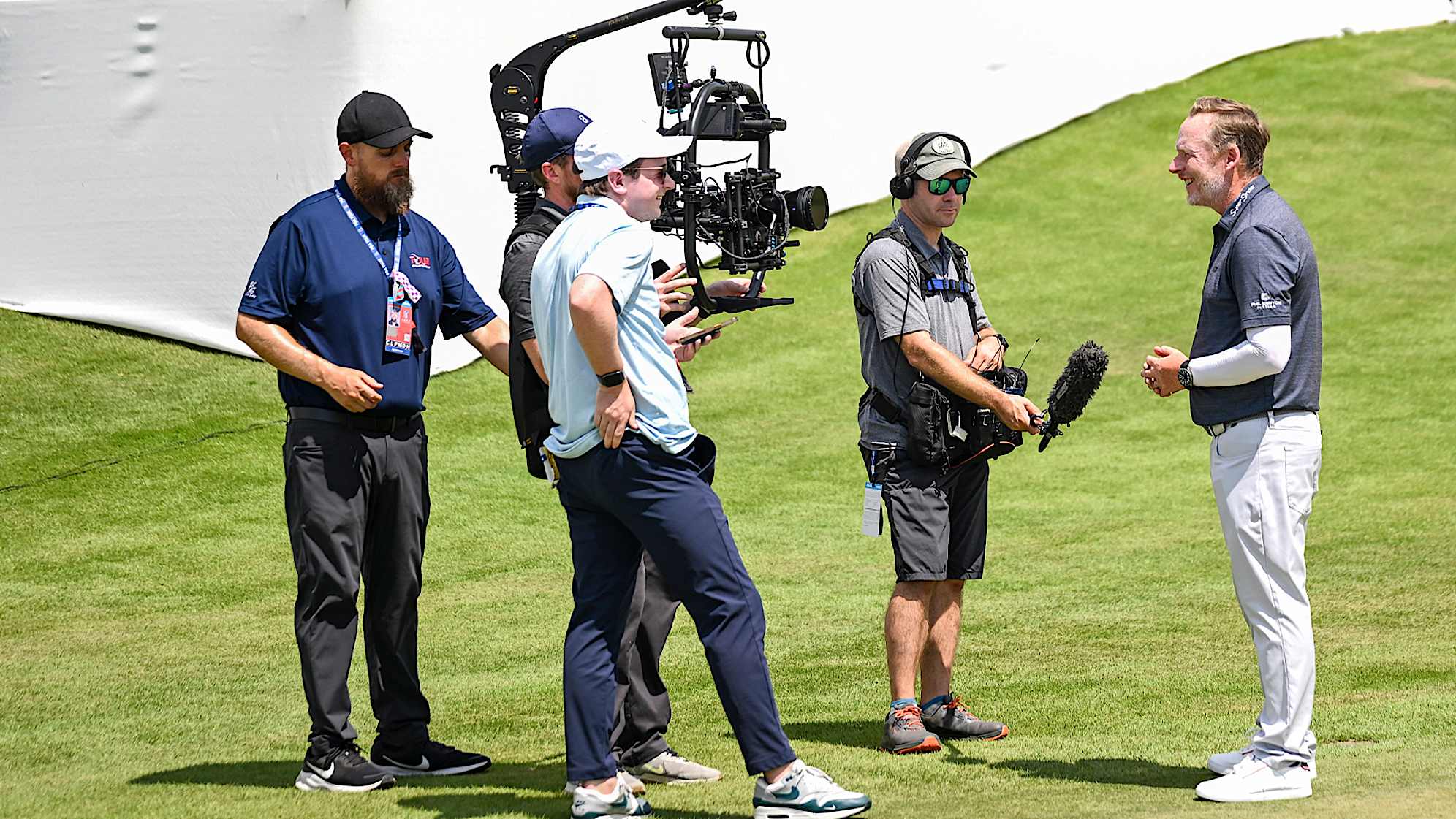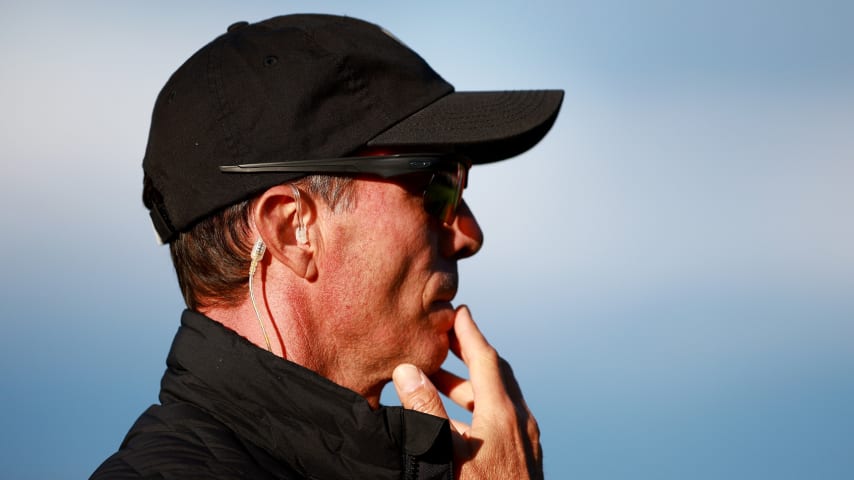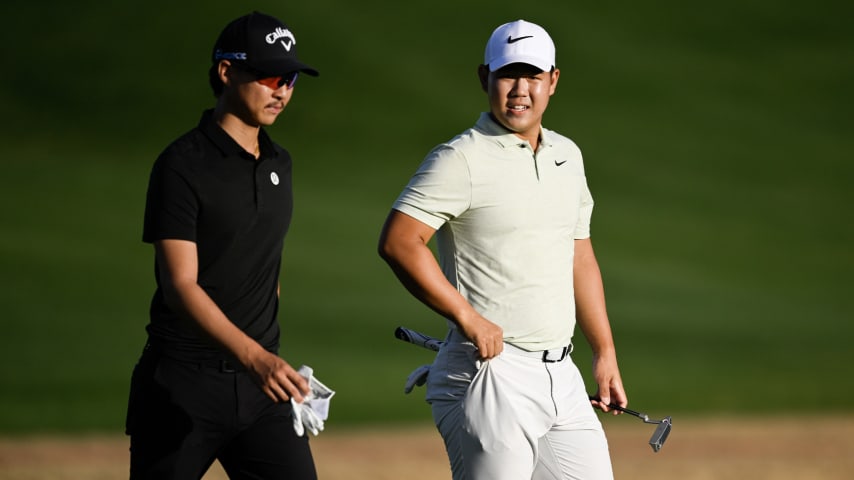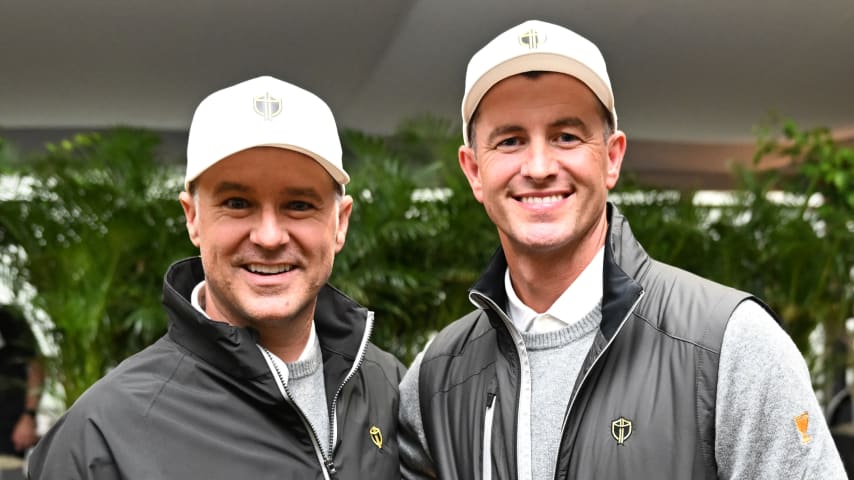Meet Phil Kenyon, the man behind Scottie Scheffler’s incredible putting turnaround
11 Min Read

Phil Kenyon describes his coaching philosophy
Written by Paul Hodowanic
Scottie Scheffler was on his plane headed home to Dallas when he sent the text.
Tired from a long season and disappointed with how it had finished, Scheffler was ready to get away, put the clubs down and unwind before the Ryder Cup later that month. Something gnawed at him, though.
A few hours earlier, Scheffler had wrapped his 2022-23 PGA TOUR season on a low note at East Lake Golf Club, finishing a distant 11 shots behind FedExCup champion Viktor Hovland. Scheffler started the week 10-under, first on the Starting Strokes leaderboard, but finished at only 11-under, tied for sixth. He’d left too many tournaments with that feeling. He won twice, yes, but given that his ball-striking recalled peak Tiger Woods, it felt like Scheffler’s obvious weak spot – his putting – had kept him from having a historically great season. He needed reassurance that he was heading in the right direction, that he could get past this glaring inefficiency and to the victories that were on the other side.
Phil Kenyon was as surprised as anyone to see the text come through. A renowned European putting coach, he is used to players reaching out to have him look at their putting, but Scheffler was never going to be one of them. For 27 years, the only coach he ever had was Randy Smith. Kenyon and Scheffler had only exchanged hellos a few times. They didn’t really know each other. But Scheffler knew Kenyon’s reputation, and he knew he had exhausted all his internal options. So Scheffler reached out, asking for help.
Within three days, Kenyon was in Dallas working with Scheffler. By the time the Ryder Cup came around, Kenyon’s teachings were taking hold. A year later, the partnership between Scheffler and Kenyon looks like one of the most consequential in recent memory. Scheffler’s putting drastically improved under Kenyon’s tutelage. He went from one of the best players in the world to the unquestioned dominant force in golf, winning seven times in 2024, including THE PLAYERS Championship, the Masters and the Olympics.
Kenyon is quick to deflect praise; the understated Englishman prefers to lurk in the background. His pupils feel differently, happy to see Kenyon’s spotlight grow, as it will at The Royal Montreal Golf Club this week. Four Kenyon clients – all Americans – are playing in the Presidents Cup. Along with Scheffler, Kenyon works with Max Homa, Keegan Bradley and Russell Henley. He has seven clients in the world’s top 40.

Scottie Scheffler (right) smiles as he speaks to Byeong Hun An (left) and putting coach Phil Kenyon (middle) during practice for the U.S. Open at Pinehurst Resort. (Keyur Khamar/PGA TOUR)
“Phil’s brilliant,” said Homa, who made the U.S. team as a captain’s pick. “He's definitely the most knowledgeable person I've ever talked to about putting.”
“He’s a very unassuming character,” said Justin Rose, another Kenyon client. “He doesn’t look for the limelight, but I’m glad he’s got it.”
It was Scheffler’s year. Those that know the backstory, though, know it was also Kenyon’s.
It’s Tuesday of the RBC Heritage, and Kenyon is the first man on the Harbour Town putting green. Less than 48 hours removed from Scheffler winning the Masters, the Texan isn’t in Hilton Head, South Carolina, yet. He won’t come until Wednesday, but Kenyon has plenty to do.
Matt Fitzpatrick shows up shortly after 7 a.m. They have the putting green to themselves, working through issues that popped up on the weekend at the Masters, where Fitzpatrick shot 73-75 to finish T22. Kenyon watches as Fitzpatrick practices a series of 5-foot putts. Kenyon’s white Odyssey bucket hat obscures much of his face, and the effect of his white polo, white sunsleeves and white pants getup is to project Kenyon as a bit of a blank canvas. In a sense, that’s what he is.
After about 90 minutes of work, Fitzpatrick leaves for the range, Kenyon stays, and Rose arrives ready for a similar debrief. This repeats throughout the day, with one Kenyon client replacing another on the putting green. Each is scheduled for a specific time slot, which has become necessary as his client list has grown. Regularly on TOUR practice greens from sunup to sundown, he won’t leave Harbour Town till 6 p.m., when he wraps with Tommy Fleetwood. Plenty have met the criteria for the “busiest man in golf” title, and while Kenyon wouldn’t want the recognition, he’s certainly in contention for it. What’s drawn this long list of clients to him is a coaching style that defies categorization.
There is no putting philosophy that Kenyon ascribes to. The game of golf is an art form, and putting is the most abstract of skills. There are three fundamentals – starting the ball on line, speed, and green reading – and there are many ways to master each. There is no "Phil Kenyon Putting Method" that could be taught in a textbook. Each player’s putting is a different puzzle Kenyon hopes to solve with different solutions; he believes coaching isn’t so much about what you know, but how you communicate it to others.

Scottie Scheffler on working on his golf game
“I've talked to people who say that when they have worked with Phil, it hasn't been technical at all,” Homa said. “I've talked to people that said maybe it was too technical, so he has a lot of range. I think that's important. And then once you as a player explain to him what you like, I feel like he has all of those, the capability to do any of it.”
How he works with Fitzpatrick is different than how he works with Fleetwood or Rose or Homa or Henley or Bradley or Scheffler. With Fitzpatrick, Kenyon is speaking in numbers. Fitzpatrick knows his statistical tendencies on every putt distance and break, and Kenyon helps craft drills to address the analytical Fitzpatrick’s deficiencies. At the same time, Fitzpatrick is not technical with the mechanics of his putting stroke. Once he knows the numbers, he’s using feels to prescribe an answer. Contrast that with Rose, whose technique is the bedrock of everything else he does on the greens. With Rose, Kenyon is hyper-focused on technique. By understanding the nuts and bolts, Rose can then narrow everything down to a simple playable feel.
“Obviously you get guys who don’t know anything about putting, and they're just great putters because it can be an art form and it can be a science,” Rose said. “And I think that you can get lost in the middle where you are half creative, half science, and you don't quite know how to apply them together. And I feel like Phil's really helped me with that side of things.
“Sometimes the more you learn about putting, it doesn't necessarily make you a better putter. And with Phil’s help, I think I've begun to learn what really matters to me.”
Others, like Homa, utilize AimPoint as a central tenet to their putting philosophy. That’s in opposition to Scheffler, who has a very traditional green-reading style.
When Kenyon and Scheffler linked up, the world No. 1 felt he was using his hands too much through the stroke, comparing it to a similar issue in college with his full swing, where his hands were too often underneath the club. It was manifesting in his putting stroke, causing too many heel strikes and pulls. Kenyon helped Scheffler clean up his technique, and with those feels engrained, pushed Scheffler to feel more athletic with his putting stroke.
“I feel like I'm in a place with my putting where I can use my feel, my instincts to kind of turn off and just go there and try and hit putts and be OK with the result whether it goes in or doesn't,” Scheffler said last December at the Hero World Challenge.
Scheffler putted well that week, his first stroke-play event since connecting with Kenyon a few months earlier. With a 20-under total, Scheffler won the tournament by three over Sepp Straka.
The result at the Hero was the first indication that Scheffler’s peers might have their hands full in 2024, and when he found the final puzzle piece – switching putters – it was the catalyst for one of the best seasons in the past quarter century. Scheffler tested “around a dozen” putters over a several-week stretch at the beginning of this year. Kenyon wanted to see what different alignment aids might help Scheffler’s setup. They ultimately landed on a TaylorMade Spider Tour X, a mallet-style putter, to replace his trusty blade.
“He was using a line of the ball to help his alignment because of a certain bias that he would have,” Kenyon said. “When we tested that putter, he could aim it really, really well. The configuration of the club helped him and then getting rid of a line of ball helped even more. That was one of the things at the time that he needed to do. He’s so competitive sometimes he tries too hard and that change really helped him work on some aspects of his routine, which was more about freeing him up.”
Scheffler put the new putter in play at the Arnold Palmer Invitational presented by Mastercard and won the event, along with three of his next four starts. Everything finally clicked; almost all of the close calls were turning into victories. Scheffler gained strokes on the greens this year, more than enough to compliment his elite ball-striking. His frustration has disappeared almost entirely; his lone deficiency has become an asset.
“I think (Scottie’s) strength of mind is underestimated by many,” Kenyon said. “He's probably the most competitive person I've met.”
By the time Scheffler won the FedExCup in August with Kenyon firmly ensconced in his stable of coaches, the narrative of how the world No. 1 fixed his putting was clear.
Still, not many knew much about Kenyon himself.
Kenyon grew up in Southport, England, a seaside town north of Liverpool known for its golf. His home was minutes from the world-famous Royal Birkdale Golf Club, a staple in The Open Championship rota. In Southport, golf is part of everyday life, and it quickly became Kenyon’s obsession. Kenyon was mentored by Harold Swash, a friend of Kenyon’s father and a world-renowned putting coach known as “Britain’s Putting Doctor.” Swash worked with the likes of Nick Faldo, Padraig Harrington, Darren Clarke and Lee Westwood.
“He helped me with my putting as soon as I could pick up a putter,” Kenyon said.
Kenyon played at John Moore University in Liverpool, where he also received a master’s degree in sports science and psychology before turning pro in 2000. He spent five years on the European mini-tours, funding his career by coaching part-time with Swash. In 2005, Kenyon quit playing and joined Swash’s academy full-time. Nearly 20 years later, Kenyon runs the academy, which still bears his mentor’s namesake: Harold Swash Putting School of Excellence. Swash passed away in 2016 at age 83.
In the early days of his coaching career, Kenyon was Swash’s “cameraman and dogsbody,” handling remedial tasks around the academy. Slowly, Kenyon took on some of Swash’s lesser-known clients, building up his own rapport and credibility. That’s when he began working with Fleetwood, who as a teenager had worked with Swash and became familiar with Kenyon as Swash’s assistant. Eventually, Swash would age out of full-time work, and more of his clients, like Fleetwood, would transition to Kenyon.
“I've known Phil for so long, and because we’re so close sometimes you forget how world-renowned he is as a coach,” Fleetwood said.
Kenyon’s big break came when Henrik Stenson brought him aboard. Stenson had already won THE PLAYERS Championship in 2009 when he took a chance on Kenyon a year later. He was a Swash client but was looking for someone more present on TOUR week-to-week as his putting and play fell off, Stenson dropping out of the top 200 in the Official World Golf Ranking. Within two years he was back in the winner’s circle and back in the top 10 of the OWGR. Kenyon was Stenson’s putting coach during his 2016 Open Championship victory.
Kenyon’s never been more in demand than now. While he’s worked with the likes of Clarke, Westwood, Francesco Molinari and Rory McIlroy during their primes, his current clientele is as accomplished as it has been at any point in his career. Kenyon added Russell Henley as a client around the same time as Scheffler, with similar results. This year, Henley ranked 37th in Strokes Gained: Putting after four consecutive seasons outside the top 100.
It is Scheffler’s incredible journey, though, that speaks loudest for the putting coach.
Kenyon was with Scheffler in the run-up to the TOUR Championship at East Lake, but once Scheffler strode onto the first tee, Kenyon headed home to Europe. His work was done.
Four days later, so was Scheffler’s. He stood on the 18th green Sunday night and received the Calamity Jane trophy, a replica of the famous Bobby Jones putter given to the winner of the TOUR Championship. Asked to hit a putt with Calamity Jane, Scheffler casually set up over a 30-footer and drained it. He smiled and walked off toward the parking lot.
Somewhere in England, a former cameraman and dogsbody was smiling.



